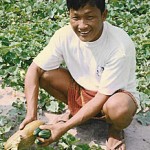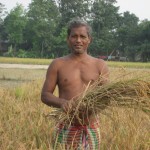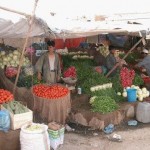
In 1978, India became a net grain exporter after adopting green revolution miracle seeds and rapidly expanding land under irrigation, yet 230 million people in India today remain malnourished, and malnutrition accounts for 50% of child deaths. How can it be that a country like India, which has produced a surplus in grain crops for more than thirty years, still has 230 million hungry people?
While increasing food production in India was successful in eliminating regular devastating famines, it did little to eradicate extreme poverty, which underlies chronic malnutrition. The fact is that the root cause of food insecurity is extreme poverty, not just shortfalls in food production. When very poor people find ways to grow their income, they buy the food they need and the market finds ways to bring it to them more efficiently than disaster relief or food distribution programs. The most direct way to end food insecurity is to help very poor rural people increase their income from farming.

Most of the 800 million or so hungry people in the world today live in poor rural areas in developing countries and earn their living from one-acre farms. They are strongly motivated to grow enough rice, wheat or corn to feed their families for the whole year, but most of them don’t have enough land, or the right kind of land to eliminate their hunger. So they and their families live on one meal a day or less for three or four months while they wait for the next rice crop to come in. My colleagues and I at International Development Enterprises (IDE) have had good results helping small farmers improve their food production with simple strategies like poking a hole in the ground with a stick between rice plants, and putting a sustained release capsule of urea in the hole. Adopting new approaches like SRI (System for Rice Intensification) can help even more.
But even if they have enough land, water and money to invest in fertilizer to produce a surplus of grain, selling it on the market is a loser’s bet for a small farmer- crops like rice rarely produce net income of more than $200 an acre, and most dollar a day farmers only have one acre to work with.

If a poor one acre farmer in India is in a position to plant an acre of rice and sell it, he might earn $200 net.
If that same farmer instead decides instead to grow drip irrigated, labor-intensive off-season fruits, vegetable and, spices, they can regularly earn $1,000 after expenses from a quarter acre. This is more than enough to buy all the food the family needs, and move out of poverty and into the middle class.
My friends at IDE and I have seen this happen thousands of times. To make it happen, it takes a whole new approach to small farm agriculture, new research to optimize it, and a last-mile private sector mass dissemination and training initiative.
If we have the courage to do it, I have no doubt that at least a hundred million of the 230 million hungry people now in India, and their brothers and sisters in other developing countries, can end their food insecurity forever.
IDE Visits Veronica’s Zambian Farm



This is such critical information. I am going to “cut and paste” to re-post it on my FB page, but it would be nice to have a button to “share” it on FB as well as Tweet it (which I already did.)
Thanks so much for this! Just want to get it out to as many people as possible, worldwide.
Sincerely,
Suzette Sommer
Thank you! Share button is about to go up!
Paul Polak: where genius and generosity go hand in hand!
Nice work on the site, Isaac – really enjoying the blogs. Thank you! Inspiration always only a click away.
Look forward to sharing developments on the project I’ve been busy working on soon 🙂
Looking forward to hearing from you soon.
Dear Paul,
Your work and IDE set an outstanding example of ways to increase the productivity and incomes of small acre farmers. It is necessary for so many reasons. I have a few questions for you:
– You talk about small acre farmers switching from a staple like rice to new, perhaps unfamiliar crops like fruits and vegetables. Can you walk us through what that transition looks like? It must feel like an enormous risk for a farmer familiar with a very different mode of production.
– You also propose the hypothetical in which millions of small acre farmers are producing labor-intensive, off-season fruits and vegetables. Can you walk us through the implications of this on local markets, and perhaps customer demand and risks of glut?
Thanks so much,
lars
Pingback: Tweets that mention Why Growing Income is More Important to Food Security than Growing More Food: If we have the courage to do it, I h... -- Topsy.com
great questions, lars
small farmers are more risk averse than the American Medical Association, with good reason- if they make a big mistake, they lose their land and end up in a city slum! So we usually start by helping them increase their rice production to come closer to being able to feed their family. Then, when they start growing high value crops, they start with the ones that are the lowest risk- kale, for instance, a leafy salad type plant is hard to kill and easy to sell, but doesn’t make much money. Then, as they become more comfortable, farmers start growing higher return crops, like tomatoes, sweet corn and coffee in Zambia, and lowering ther risks by growing 4 or 5 different crops instead of just one.
Everybody worries about flooding the market if too many farmers start growing fruits vegetables and spices, but before we recomend a crop, we check with market wholesalers about demand patterns in local, regional, national and export markets, and recomend only those crops that are likely to have significant lasting demand. For instance, in Maharastra India we recomend pomegranate, because it has vast unment demand in the Delhi market, backed by huge demand in the Middle East. Finally, since you can never predict the future value of every crop, we recomend that small farmers grow four or five, making it extremely likely that at least one will be a winner
paul polak
I have a small self-funded project in the Department of Cordoba Colombia SA called “Mas Dinero” built on the idea that we can create more income for BOP farmers by having them grow high value food commodities (see http://home.comcast.net/~prigter/site/ ). I am being helped by the teachers at the University of Cordoba and their students who train the BOP farmers to become more productive with traditional crops (cassava, platino, etc) as well as new crops (moringa, uberlandia carrots, tropical fruit trees, etc). We use business process re engineering techniques for preparing our business plans, cost plane, marketing plans, etc. It is very dangerous for an American to travel in this region so most of the outreach is done by the University of Cordoba and the community development workers who work for the Bishop of Monteria. It will take a few years to know whether I will be successful.
One immediate success I had was bringing sports equipment (softball, badmitton, golf, horseshoes) into the area as well as a few hundred Obama buttons (my son’s girlfriend worked on Obama’s senate campaign and was their babysitter for a couple of years). It is important for poor people to have fun and a little controversy while they are waiting to see if new crops can increase their income.
The use of high value food commodities to increase the income of small farmers in the United States has been very successful. To understand what was done I suggest people read the classic handbook by Dr. Booker T Whatley (Tuskegee University) on “How to Make $100,000 on a 25 Acre Farm”
Hello Paul
the mas dinero program sounds very interesting. I don’t have much experience with bringing in sports equipment, but a friend of mine, Steve Alison, is sending soccer balls to Africa and feels it makes a big difference. Your strategy of helping poor farmers grow income generating crops is a winner, but of course it all depends on how well the University of Cordoba and its students implement it.
I wish you every success!
Paul Polak
Paul P
Thanks for your encouragement. The 10 agriculture engineers at the University of Cordoba are trying their best to be successful. They have a great outreach program that was in place before I arrived. They want to show President Obama, his wife, and his children that they are good people and, given a chance, they will be successful. My ideas are being copied in other parts of northern Colombia so I feel the ideas will be given a fair test.
With regard to sports equipment, I know that many people in extreme poverty are deeply depressed. Giving them sports equipment (and ideas for how to improve their standard of living) causes people in extreme poverty to be a little less depressed so that they try own ideas for improving their standard of living as well as the ideas that I suggest.
Dear Paul
with much interest I read your explanation on how to reduce risk of small farmers. In the informative Zambia movie I see that they are using the Treadle pump for irrigation which can pump from depths till 7 meters deep. For wells to 30 meters deep organisations as DAPP in Zambia, Malawi and Zimbabwe are using the rope pump for irrigation and in Zimbabwe there are now examples that 1 rope pump in provides water for domestic use and irrigation to feed 80 people all year round. More information on the websites of DAPP or Connect International. Succes with your always motivating activities.
Henk Holtslag
thanks Henk
I’ve been an admirer of your work for a long time, and IDE has direct experience with the usefulness of rope and washer pumps in countries like Ethiopia. This pump lifts water from much deeper water tables than the treadle pump, but of course, the deeper you go, the less water human power can lift, so for irrigation purposes, its often useful to combine a rope and washer pump with water distribution devices like low cost drip irrigation, which gets twice as much crop per drop. Does the rope pump which feeds 80 people in Zimbabwe use drip irrigation?
I applaud your success in deseminating rope and washer pumps aroung the world.
paul polak
Wondering what think tanks could be initiated – or already in existence – for generating local ideas for developing enterprise. What can be created at the local level empowering individuals ideas?
As basic needs get met, people have energy, drive & self-belief to do & become more. No-one wants to be at the mercy of large corporations – people are creative and such energy needs to go someplace. I always smile more when giving something I feel proud of to another than I do when in need of something myself. Giving is receiving at it’s best! It’s about self-worth, value, identity & belonging. It’s human nature. What we do with our creativity defines who we are. What does your spirit desire?
When I first saw the images in Pauls Blog (and this was back at UBC a couple of months ago now), my initial response was ‘commercialism verses need’. I am thinking Iars comment above (reference ‘glut?) touches on this concern. It was monopolization of one-way markets dominating the 20th century that has much to do with our present state of affairs. To leave in peace in this world, we must harness individualism. We must learn to see one anothers ideas and success as rocket launches for our own. If fear of competition could be replaced with joy of self-empowerment, just how far could society go?
Something I wrote some time ago now: ‘We are each independently dependent on our interdependence.’ May we learn to embrace one anothers success as fuel that feeds our own!
Loving the energy here. So many want change. So many ideas. Change will come.
Caroline
ps. meant to say ‘consumerism vs need'(as opposed to ‘commercialism’). Slight difference – sorry!
Caroline, I think your philosophy about harnessing individualism as fuel for success is really beautiful and exciting. I imagine a local metamarketplace that physically rewards local innovation, with a community dream of interdependent wealth surpassing the dream of independent wealth. Perhaps an economy that gifts opportunity.
Isn’t that beautiful? How it all comes together: better access to water, better use of land, selection of right crops and improvement in quality of life (purchase of home, better education for children, better diet…) and the list goes on of significant improvements.
Paul, you and IDE are doing wonderful work around the world.
The question of growing the right crops (seasonal, exotic fruits and legumes) has been often brought up in many areas: in Mali for example, some farmers are pressured (by government and/or loan providers) to grow cotton versus growing other crops that are more profitable. So there is definitely a policy problem and a need for greater support of farmers in rural areas in the world.
Thank you
thank you Hadji
I very much like what you are doing as well in supporting business appraoches to water and sanitation in Africa
paul polak